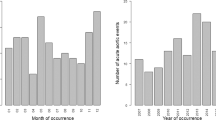Abstract
This study examines whether a relation exists between rapid atmospheric pressure fluctuations, attributed to the far infrasound frequency range (APF), and a number of emergency transport events coded as circulatory system diseases (EEC). Over an entire year, the average integral amplitudes of APF in the range of periods from 3 s to 120 s over each hour (HA) were measured. Daily dynamics of HA averaged over the year revealed a wave shape with smooth increase from night to day followed by decrease from day to night. The total daily number of EEC within the city of Kiev, Ukraine, was related to the daily mean of HA (DHA) and to the ratio of HA averaged over the day time to HA averaged over the night time (Rdn), and was checked for confounding effects of classical meteorological variables through non-parametric regression algorithms. The number of EEC were significantly higher on days with high DHA (3.72–11.07 Pa, n = 87) compared to the low DHA (0.7–3.62 Pa, n = 260, p = 0.01), as well at days with low Rdn (0.21–1.64, n = 229) compared to the high Rdn (1.65–7.2, n = 118, p = 0.03). A difference between DHA and Rdn effects on the emergency events related to different categories of circulatory diseases points to a higher sensitivity of rheumatic and cerebro-vascular diseases to DHA, and ischaemic and hypertensive diseases to Rdn. Results suggest that APF could be considered as a meteorotropic factor capable of influencing circulatory system diseases.



Similar content being viewed by others
References
Bedard AJ, Georges TM (2000) Atmospheric infrasound. Phys Today 3:32–37
Cooke LJ, Rose MS, Becker WJ (2000) Chinook winds and migraine headache. Neurology 54:302–307
Danet S, Richard F, Montaye M, Beauchant S, Lemaire B, Graux C, Cottel D, Marecaux N, Amouyel P (1999) Unhealthy effects of atmospheric temperature and pressure on the occurrence of myocardial infarction and coronary deaths. Circulation 100:e1–e7
Delyukov A, Didyk L (1999) The effects of extra-low-frequency atmospheric pressure oscillations on human mental activity. Int J Biometeorol 43:31–37
Didyk LA, Bogdanov VB, Lysenko VA, Didyk NP, Gorgo YP, Dirckx JJJ (2007) The effects of slight pressure oscillations in the far infrasound frequency range on the pars flaccida in gerbil and rabbit ears. Int J Biometeorol 51:221–231
Dirckx JJJ, Decraemer WF, von Unge M, Larsson CH (1998) Volume displacement of the gerbil eardrum pars flaccida as a function of middle ear pressure. Hear Res 118:35–46
Feijen RA, Segenhout JM, Albers WJ, Wit HP (2002) Changes of guinea pig inner ear pressure by square wave middle ear cavity pressure variation. Acta Otolaryngol 122:138–145
Gossard EE, Hooke WH (1975) Waves in the atmosphere: atmospheric infrasound and gravity waves – their generation and propagation. Elsevier, Amsterdam
Green JE, Dunn F (1968) Correlation of naturally occurring infrasonics and selected human behaviour. J Acoustic Soc 44:1456–1457
Guo Y-F, Stein PK (2003) Circadian rhythm in the cardiovascular system: chronocardiology. Am Heart J 145:779–786
Halberg F, Reinhart J, Bartter F, Delea C, Gordon R, Wolff S, Reinberg A, Ghata J, Hofmann H, Halhuber M, Gunther R, Knapp E, Pena JC, Garcia SM (1969) Agreement in endpoins from circadian rhythmometry on healthy human being living on different continents. Experientia 25:106–112
Humphreys WJ (1929) Physics of the air. McGraw-Hill, New York
Kompanets VS (1968) Effects of repeated opposite directional changes in the barometric pressure on man. Voenno-medicinsky zhurnal 6:61–63 (in Russian)
Lumley JI, Panofsky HA (1964) The structure of atmospheric turbulence. Interscience, New York
Majidov NM, Sidiki MU, Kilichev IA, Halimova ZY, Gnedykx ON (1991) The effects of meteorological factors on the death rate from brain strokes in the flat countries of the Middle Asia. Zn Nevropatol Psikhiatr Im SS Korsakova 91(11):48–49 (in Russian)
McNamee R (2005) Regression modelling and other methods to control confounding. Occup Environ Med 62:500–506
Mezernitsky PG (1934) Medical meteorology. Brief handbook. GIMK, Yalta-Crimea (in Russian)
Naito Y, Ito J, Tsuji J, Honjo I (1988) The influence of middle ear pressure on the otolith system in cats. Arch Otorhinolaryngol 245:321–324
Richner H, Graber W (1978) The ability of non-classical meteorological parameters to penetrate into buildings. Int J Biometeorol 22:242–248
Rockley TJ, Hawke WM (1992) The middle ear as a baroreceptor. Acta Otolaryngol (Stockh) 112:816–823
Smolensky MH, Tatar SE, Bergman SA, Losman JG, Barnard CN, Dasco CC, Kraft IA (1976) Circadian rhythmic aspects of human cardiovascular function: a review by chronobiologic statistical methods. Chronobiologia 3:337–371
Storlie CB, Helton JC (2005) Multiple predictor smoothing methods for sensitivity analysis. In: Kuhl ME, Steiger NM, Armstrong FB, Joines JA (eds) Proceedings of the 37th 2005 Winter Simulation Conference, Orlando, Fla., USA, pp 231–239
Temnikova NS (1977) The influence of atmospheric pressure on cardiovascular diseases. Gidrometeoizdat, Leningrad (in Russian)
Troshin VD, Suchkina EG (1986) Effects of meteoro-heliofactors on psycho-physiological reactions in healthy subjects and patients suffering from brain vascular damage. Zn Nevropatol Psikhiatr Im SS Korsakova 86:1320–1323 (in Russian)
Vladymirsky BM (1982) The atmospheric infrasound as a possible physical agent transferring solar activity influence to the biosphere. Probl Kosm Biol 43:174–179 (in Russian)
Voronin NM (1981) The basis of medical and biological climatology. Medicina, Moscow (in Russian)
Yates BJ, Goto T, Bolton PS (1993) Responses of neurons in the rostral ventrolateral medulla of the cat to natural vestibular stimulation. Brain Research 601(1–2):255–264
Acknowledgments
This study was supported by the NATO Program Security Through Science, Collaborative Linkage Grant number 98376, and by funds from the University of Antwerp (BOF-NOI). The authors thank Mr. F. Wiese and Mr. W. Deblauwe for technical support and providing atmospheric pressure monitoring data at Antwerp University.
Author information
Authors and Affiliations
Corresponding author
Rights and permissions
About this article
Cite this article
Didyk, L.A., Gorgo, Y.P., Dirckx, J.J.J. et al. Atmospheric pressure fluctuations in the far infrasound range and emergency transport events coded as circulatory system diseases. Int J Biometeorol 52, 553–561 (2008). https://doi.org/10.1007/s00484-008-0163-6
Received:
Revised:
Accepted:
Published:
Issue Date:
DOI: https://doi.org/10.1007/s00484-008-0163-6




